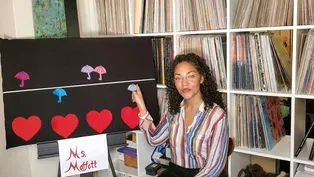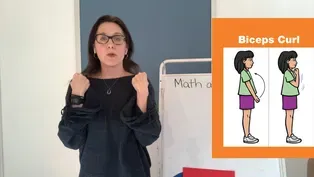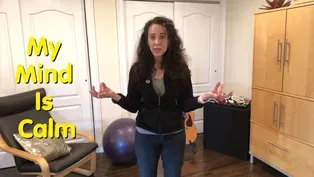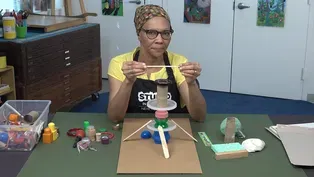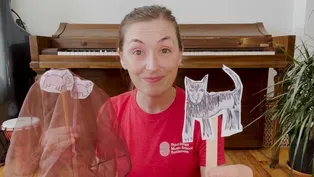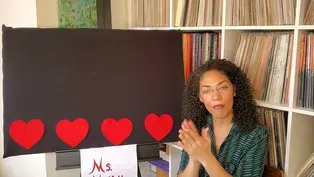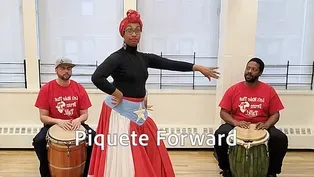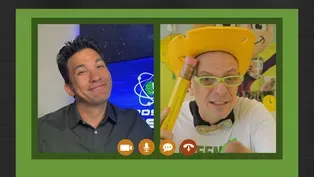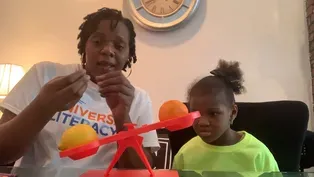
Can You Hear the “sh” in Wish?
2/19/2021 | 56m 43sVideo has Closed Captions
Visit parts of a neighborhood, read THE MANY COLORS OF HARPREET SINGH & COUNT ON ME.
Visit parts of a neighborhood, learn about feelings and friends, count 1-10, read THE MANY COLORS OF HARPREET SINGH and COUNT ON ME. LET’S LEARN helps children ages 3-8 with at-home learning. One-hour programs feature instruction by educators and virtual field trips.
Problems with Closed Captions? Closed Captioning Feedback
Problems with Closed Captions? Closed Captioning Feedback
Let's Learn is a local public television program presented by THIRTEEN PBS

Can You Hear the “sh” in Wish?
2/19/2021 | 56m 43sVideo has Closed Captions
Visit parts of a neighborhood, learn about feelings and friends, count 1-10, read THE MANY COLORS OF HARPREET SINGH and COUNT ON ME. LET’S LEARN helps children ages 3-8 with at-home learning. One-hour programs feature instruction by educators and virtual field trips.
Problems with Closed Captions? Closed Captioning Feedback
How to Watch Let's Learn
Let's Learn is available to stream on pbs.org and the free PBS App, available on iPhone, Apple TV, Android TV, Android smartphones, Amazon Fire TV, Amazon Fire Tablet, Roku, Samsung Smart TV, and Vizio.
Providing Support for PBS.org
Learn Moreabout PBS online sponsorshipMore from This Collection
Video has Closed Captions
Read SCHOOL BUS and draw one, learn about prefixes and pitch, build sculptures. (57m 48s)
Running and Counting Both End in “ing”!
Video has Closed Captions
Move to improve, find the missing number, learn songs from Ghana, read ABUELITA’S SECRET. (58m 17s)
What Sound Does “aw” Make in Draw?
Video has Closed Captions
Read a story, discover "au" and "aw," learn about density, count, and move with music. (56m 58s)
Can You Find the Short “u” in Subtract?
Video has Closed Captions
Help Super Grover 2.0 solve a prickly problem, read ALL THE WAYS TO BE SMART. (56m 19s)
What Sound Does “gl” Make in Glove?
Video has Closed Captions
Play the glockenspiel, help Super Grover 2.0 make a cart move, read TWO WOOL GLOVES. (58m 9s)
Incredible Starts with Short “i”!
Video has Closed Captions
Solve problems with Super Grover 2.0, catch a rainbow, hear a piano sound like a cuckoo. (56m 9s)
What’s the Sound of “oo” in Book?
Video has Closed Captions
Explore animals’ form and function, sing about the 3 little pigs, read THE LITTLE BOX. (58m 15s)
We’re Reducing, Reusing and Recycling!
Video has Closed Captions
Learn all about rhythm and the number 9, read A BAG IN THE WIND. (56m 17s)
Video has Closed Captions
Learn to dance bomba and grow food in a city, read WOLF CUB’S SONG. (55m 20s)
How Many Syllables are in Invent?
Video has Closed Captions
Invent your own instrument, make 10 to add numbers to 20, read ONE GOLDEN RULE AT SCHOOL. (57m 36s)
Video has Closed Captions
Learn about the science behind mind reading, count shells, read MY BIG FAMILY. (57m 27s)
Which is Heavier: One Apple or Two Apples?
Video has Closed Captions
Defy gravity, learn secret code words for fast and slow in music, read WHOOO KNEW? (58m 5s)
Providing Support for PBS.org
Learn Moreabout PBS online sponsorship- [Narrator] Ready to learn?
- [Both] Hi!
- [Narrator] It's time to share a story... - Shhh.
- [Narrator] Read and write... - Let's read it back.
- [Narrator] Discover science.
Sing.
♪ Somewhere ♪ - [Narrator] Play and so much more.
- Cupcake!
- Very good.
- [Narrator] Stay tuned for lessons and activities.
- We're gonna start making some words.
Isn't that fun?
[upbeat music] - [Narrator] Funding for this program was provided by the JPB foundation.
- Hi everyone.
This is "The Many Colors of Harpreet Singh," written by me, Supriya Kelkar, illustrated by Alea Marley.
Afterword by Simran Jeet Singh.
"The Many Colors of Harpreet Singh."
"Harpreet Singh loved his colors; "bright, muted, pastel or neon, "he had one for every occasion.
"He wore yellow when he felt sunny.
"Spreading cheer everywhere he went.
"He wore pink when he felt like celebrating, "bopping along to bhangra beats.
"And he wore red when he needed "an extra boost of courage.
"Harpreet took great care of his colorful patkas.
"He made sure they were clean and soft, "smoothing each one out gently before putting it on.
"One day, Harpreet's mom announced "that she found a new job "in a snowy town across the country.
""It'll be fun," his mom said.
""It'll be an adventure," said his dad.
""It won't be the same," said Harpreet.
"Saying goodbye took a lot of courage.
"Harpreet also had colors for not so happy occasions.
"He wore blue when he felt nervous, "his heart thumping in his chest.
"He wore gray when he was sad, "like a cloud about to rain.
"And he wore white when he felt shy, "not wanting to be seen.
"Lately, at his new school, "Harpreet had been wearing white an awful lot.
"He wore it on a field trip.
"He wore it for a class party.
"He even wore it on ordinary days "because even on ordinary days, "he wanted to be invisible.
""Do you want to wear red?"
"His mom asked.
""No reason to be brave," Harpreet replied.
""How about pink?"
"Asked his dad.
""What's there to celebrate?"
"Said Harpreet.
""Maybe all you need," said his mom, ""is a little sunshine."
"Harpreet shook his head and sighed.
""Look outside.
""No birds, no blooms, no beach.
""Just cold."
"The next day, Harpreet went to school in white, "feeling gloomier than ever before.
"It seemed like everything in this town was frowning "along with him, "even the snow.
"But it wasn't a frown at all.
"It was a smile.
"And Harpreet knew who it belonged to.
""I like your hat," said Harpreet.
""I like your hat," said the girl.
""Mine's not a hat, actually.
""It's called a patka," said Harpreet.
""Mine's itchy," said the girl.
"Harpreet laughed.
""I'm Harpreet," he said.
"The girl extended a mitten.
""I'm Abby."
"The next day, Harpreet was sure to wear red.
"For a class party a week later, "he tried pink.
"It wasn't long before he dug his yellow patka "out of his drawer.
"He made sure it was clean and soft, "smoothing the wrinkles out gently "before putting it on.
"Soon, the trees had buds "and the outdoors were filled with the sounds "of chirping birds.
""All that's missing is the beach," said Harpreet's mom.
"She turned to Harpreet.
""So what color are you wearing tomorrow?"
"Harpreet thought for a moment.
""Maybe white," he said "and smiled.
"It reminds me of snow.
"Yes, Harpreet Singh loved his colors.
"He had one for every occasion, "even for just hanging out with a friend."
And that was "The Many Colors of Harpreet Singh."
- Hello, my name is Miguel Tanco.
I'm an author and illustrator for children books.
I'm here at my studio, at home.
I live in Italy, in Milan, but I'm from Spain.
I speak a little bit English.
I was living in New York for three years but you can see, my English is a little rusty.
I hope you can understand me well.
Well today, I'm gonna read and I'm going to tell you about a little bit about one of my books.
It's called "Count on Me."
And we're gonna discover it together.
Well, this is a book that speak a little bit about passions, the things that we like to do in life.
I like to illustrate, to make stories.
I like a lot to paint, to draw.
We're going to discover the passion of this little girl.
Here, this is a little hint but I think we cannot tell you yet.
Let's see.
Okay, let's go.
Here, you can see she's playing hopscotch.
That's another hint.
"At home, everyone has a passion.
"My dad has one."
You can see the passion of the dad is the same as mine.
"And my mom has another one."
Mom likes insects.
She's an entomologist.
"My brother loves music "and he's getting very good at it."
You can see the brother.
"At school, there are all sorts of activities "that could be my passion."
Let's see.
Acting, dancing, painting, cooking, singing, tennis, karate, playing music.
"I've tried them all "but there's just [indistinct]."
Let's see if we discover the passion of this guy.
"There's one thing that I really like though."
Can you see?
Math.
She's doing math in painting classes.
I did the same but the opposite.
"Math is all around us.
"It's often hiding "and I love finding it."
Can you find math here?
It's very difficult to find math here.
Let's see how the girl finds math all around her.
The geometrics shapes in the playground.
Do you know what geometric shapes are?
It's like triangle.
They're like squares, circles.
"And when we go to the lake, "I skip stones "to see the concentric circles form in the water.
"We live in a world of shapes "and I like to play with them.
"It's fun for me to find the perfect curve "and solve difficult group problems.
"I use math every day.
"I know that my passion can be hard to understand."
She's finding math in the paintings.
It's very strange.
"But there are infinite ways to see the world "and math is one of them."
This is the end of the book but then there's a little surprise.
What is this?
She's writing a journal.
If you pay attention on the other pages, she has a journal.
Can you see it?
The journal is here.
She write in the journal all the math that she's finding out.
Can you see here that she's writing?
So then, you can see in the journal all the thing that she wrote.
All the things about math.
You can see the fractals on the trees.
You can see the polygons.
You can see the concentric circles.
You can see the solid figures.
And you can start a little bit math with this little journal to go.
The trajectories, the kind of sets.
So this is the end of the book.
I dedicate this book to the people who follow their passion and reach the stars.
To follow your passion, it doesn't matter how strange it is.
Well as you can see, math could be fun also.
You can see the world through math like this little girl.
If you want, you can play a little bit with... Like the girl does.
You can go outside and see the trees.
You can see the hiding figures, like the geometric figures.
You can see the fractals.
There are a lot of fractals in nature.
There's a lot of hiding math outside and you can find it.
It's a great game and I think you're gonna enjoy it.
Well, that's it.
Thank you very much for watching.
I had a lot of fun making this book and I had a lot of fun discovering the hiding math in nature and I hope you do too.
Bye.
- Hi, movers and shakers.
This is Violet and we're going to do a special dance today.
So I want everyone to either stand up or sit up really tall in your seat, around the floor and we're gonna do the hokey pokey.
Are you ready?
♪ You put your left hand in ♪ ♪ You put it in left hand out.
♪ ♪ You put your left hand in ♪ ♪ And you shake it all about ♪ ♪ You do the hokey pokey ♪ ♪ And you turn yourself around.
♪ ♪ That's what it's all about ♪ ♪ You put your right hand in ♪ ♪ You put your right hand up ♪ ♪ You put your right hand in ♪ ♪ And you shake it all about ♪ ♪ You do the hokey pokey ♪ ♪ And you turn yourself around ♪ ♪ That's what it's all about ♪ - All right, you ready to put your leg in?
♪ You put your left leg in ♪ ♪ You put your left leg out ♪ ♪ You put your left leg in ♪ ♪ And you shake it all bout ♪ ♪ You do the hokey pokey ♪ ♪ And you turn yourself around ♪ ♪ That's what it's all about ♪ ♪ You put your right leg in ♪ ♪ You put your right leg out ♪ ♪ Put your right leg in ♪ ♪ And you shake it all about ♪ ♪ You do the hokey pokey ♪ ♪ And you turn yourself around ♪ ♪ That's what it's all about ♪ - Bye guys.
[upbeat music] - Well, hello again, friends.
My name is Renata and we're going to have a blast today.
We're gonna explore something called "alliteration."
What is that?
Well, that's when we listen for and notice the same sound at the beginning of a word.
Then, we're gonna explore the sound, "sh" and the spelling, "S-H." At the end, we'll read together and write a little bit.
If the adults in the room can find something for your learner to write with, that would be great.
Let's get started.
Okay learners, say that fancy word with me: "Alliteration."
Yes, it means we can listen and notice the same sound in the beginning of a word.
So listen to this word, "Say."
Listen to this word, "Sync."
Yes, they have the same sound.
"S-."
Repeat these words after me and notice the pictures.
"Hug."
"horse."
Good, make the first sound.
"H-" Next one.
"Soup."
"Sand."
Good.
"S-."
Say "shark," "ship."
Yes, "Sh-" Say "House," "Head."
Yes, "H-" Last one.
How about "shop," "shack"?
Yes, "Sh-."
You just noticed the sound, "S-," the sound, "H-" and the sound, "S-" in the beginning of words.
Can you think of something else that had the first sound, "S-"?
Tell me.
Excellent.
What about the sound, "H-"?
Great.
Can you come up with something that starts with the sound, "Sh-"?
Nice work learners, let's move along.
Okay learners, now we're gonna blend some sounds to say words.
We're gonna play a little game.
I'm going to say a sentence and it's gonna have a mystery word that you have to blend and say.
Let's practice.
Listen to this sentence.
"The sh-ip is sailing away."
What's that word?
"Sh-ip."
Yes, the word is "ship."
The sentence is, "the ship is sailing away."
Here's a sentence for you, ready?
"I will borrow h-is game."
"H-is."
Yes, "his" is the word.
The sentence is "I will borrow his game."
Next one, coming up now.
Listen closely.
"I feel f-ine today."
"F-ine."
Yes, "Fine" is the word.
And the sentence is "I feel fine today."
Next one coming up.
"The farm has a sh-ed."
"Sh-ed."
Yes, "Shed."
The word is "shed" and the sentence is, "The farm has a shed."
Last one, you're doing a great job.
"Nat is s-ix years old."
"S-ix."
Yes, "six" is the word.
The sentence is "Nat is six years old."
High five learners.
You just blended sounds to say mystery words.
Okay learners, now we're gonna play a game and you're going to hear the sound "Sh" inside words.
The game will be, "Well, we have to change "the first sound in the word."
I'll say a word, then I'll ask you to change the first sound and then you'll tell me the new word.
Let's practice.
Say this word with me: "Fish."
Good.
Listen how I change the sound "F-" in the beginning of fish to "W-".
"W-ish."
"Wish."
The new word is "Wish."
Your turn.
The word is "Top."
Change the sound "T-" to "Sh-" "Shop," you got it.
Next word, say "Back."
Good.
Change the sound "B-" to "Sh-."
"Shack."
Next one.
Say "dash."
Chang the sound "D" to "S-."
"Sash."
What about "Rush"?
Change the sound "R-" to "H-."
"Hush."
Last one.
Say "Well."
Change the sound "W-" to "Sh-."
"Shell."
Amazing.
That's not easy, learners.
You're doing a great job.
So learners, we've gotten to the last part of our lesson where we're gonna read and write together.
So I need to show you the spelling of that special sound you keep hearing.
"Sh-," two letters.
S and H, by themselves they represent a different sound but when you put them together, they represent a new sound.
And that new sound is "Sh."
These two letters together are called a diagraph.
Can you say "diagraph"?
Excellent.
And the sound, "Sh."
Let's see if we can make a word that we can read.
Here we go.
Watch me blend.
"Sh-," "I-," "P-."
"Shi-."
"Ship."
The word is "ship."
Let me change something and we can read a new word.
How about said, "Sh-," "I-," "N-"?
"Shi-."
"Shin."
The new word is "Shin."
Nice work.
Now, we're gonna blend and read a number of words and we're gonna write together.
So see if you can find something to write with.
Anything; paper, pencil or a whiteboard.
Okay learners, we're gonna blend to read some words.
You're going to notice that diagraph, "S-H," inside these words.
You'll see it at the beginning or at the end so pay attention.
Here we go.
"M-", "A-," "Sh."
"Ma-, "-Sh."
Mash.
"D-," "A-," "Sh."
"Da-," "-sh."
"Dash."
"D-," "I-," "Sh."
"Di-," "Sh."
"Dish."
"W-," "I-," "Sh."
"Wi-," "Sh.
"Wish."
Now, we'll blend a little faster.
"F-", "-Ish."
"Fish."
"H-," "-Ush."
"Hush."
"C-," "-ash," "Cash."
"S-," "-Ash."
"Sash."
"Sh-," "-ip."
"Ship."
"Sh-," "E-," "-Ll".
"Shell."
"Sh-," "-op".
"Shop."
"Sh-," "-Ut."
"Shut."
Now, let's read a little sentence on the bottom.
We'll blend some of the words and some of them, you'll already know.
"The "T-, "-an," ""Tan" cat "Sh-," "-Ed," ""shed" "F-, "-uzz," "fuzz" on "J-," "-An," "Jan." You just read, "The tan cat shed fuzz on Jan." Nice blending and reading friends.
Okay learners, now we're gonna have a chance to write some words with that diagraph, "Sh".
We're gonna write some words that begin with S-H and some words that end with S-H. We just read a bunch, So let's see if we can test ourselves.
Let's write a word that begins with S-H. How about "ship"?
Make the sounds with me.
"Sh-," "-I," "-P." Let's write them down.
"Sh-," "-I," "-P." Nice work.
Let's try another.
How about "shop"?
Make the sounds.
"Sh-," "-O," "-P." Let's write the word.
"Sh-," "-O," "-P." Oh, how about "shell"?
Make the sounds.
"Sh-," "E-," "-Ll".
Let's write it.
"Sh-," "E-," "-Ll".
Nice work.
One more.
How about "shut?"
Make the sounds.
"Sh-," "-U," "-T." Let's write it.
"Sh-," "-U," "-T." Wow, you just wrote four words with the diagraph, "Sh."
Ship, shop, shell, shut.
Now, let's see if we can write some words that end with "Sh."
How about "wish"?
Make the sounds.
"W-," "I-," "Sh."
Write it down.
"W-," "I-," "Sh."
Great.
How about "dish"?
Make the sounds.
"D-," "I-," "Sh."
Let's write it.
"D-," "I-," "Sh."
Great job.
Let's try "mash."
Make the sounds.
"M-", "A-," "Sh."
Let's write it together.
"M-", "A-," "Sh."
Almost done.
One more word.
How about "hush"?
Make the sounds.
"H-," "-U," "-Sh."
Let's write it.
"H-," "-U" "Sh."
Amazing, you just wrote four words that end in S-H.
Wish, dish, mash and hush.
Amazing job today, learners.
Well learners, we've reached the end of our lesson today.
We explored "alliteration," listening for the same sound in the beginning of a word.
We also worked with the sound, "Sh" and the diagraphs spelling, "S-H".
We blended to say, read and write words together.
Nice work.
Please join us tomorrow for more.
And you can practice all these activities at home with a trusted adult.
Until next time, Bye.
[upbeat music] - I check the labels on my kids' lunchboxes and toys.
Wanna know why?
- [Narrator] The dangers of lead might feel like old news but it's still a very real threat.
Lead is a dangerous metal that can cause serious learning and behavior problems in children and problems during pregnancy.
People with lead poisoning usually don't look or feel sick.
Lead can be found in old paint and in some products from other countries.
Here are a few things to look out for to protect yourself and your little ones from lead.
Lead paint was banned in New York City but some buildings may still have lead in the older layers of paint..
If you notice peeling paint in your home, talk to your landlord immediately.
If your landlord doesn't act quickly, report the peeling paint to 3-1-1.
Health remedies, foods, spices, pottery, cosmetics, toys and jewelry from certain countries may contain lead.
Use with caution.
If the paint on a toy cracks, throw it out.
It's not worth risking exposing your child to lead.
Safe lunchboxes are labeled "lead-free."
Be sure to check for this label before you buy your little one a lunchbox.
Remind your doctor to test your one or two year old for lead poisoning.
Lead your family away from lead.
[upbeat music] - Hi friends, I'm Miss Lauren and today, we are going to be doing some fun activities with numbers, zero through 10.
The first thing we're gonna do is take a look at what numbers look like in written form.
And we need to make sure we understand what each number represents.
So we're gonna do that first.
Then we're gonna be counting some objects, up to the number 10, and then we're gonna be playing a game called, "Who has more?"
All right.
So if you would like to interact and do some things along with me when I do them, these are some materials that you can have.
If you have 10 of something...
So, like for me, I'm going to be using some markers, all right?
So if you have 10 markers, 10 crayons, if you have 10 pieces of Cheerios, 10 cotton balls, whatever it is that you may have that's close to you, you can use that and a whiteboard, right?
Something to write with, all right?
So I'm gonna give you a few seconds to go ahead and grab something.
Grab those materials.
10 of something and something to write with, either a whiteboard and a marker or paper and pencil, okay?
And a crayon.
All right, I'm gonna play a little music and when the music stops, I'll begin.
All right, friends, go ahead.
[upbeat music] All right, friends.
First, we're going to take a look at numbers zero through 10, and we need to know two things.
We need to know what they look like, right?
Number one.
And we need to know what they represent, right?
'Cause numbers represent something.
So let's take a look.
Let's start with this number.
Do you know what this number is?
Yeah.
This number is zero, right?
Zero.
And it represents... Well, it represents none or nothing, right?
Let me give you an example.
How many markers do I have in my hand?
None, right?
I don't have any.
So if I was to represent that on paper, in written form, I would use this number.
This is the number zero.
Does that make sense?
All right, let's do another one.
Let's take a look at this number.
Do you know what this number is?
Yeah, that's the number one.
So, for example, if I asked you, I'll hold it, "how many markers am I holding?"
Well, I'm holding one marker.
So if I had to write that down, I would use this number.
This number, one, represents something.
It could be one marker, it could be one pencil, it could be one person, it could be one whiteboard, right?
It just represents one of something, all right?
So I'm gonna go ahead and start writing numbers on the board.
If you would like to do that, you could do it along with me.
So we're gonna practice writing our numbers and then we're going to make the circles underneath to represent what each number stands for, okay?
So the first number we said was "zero."
So when you make the zero, start at the top.
It's kind of like a nice big goose egg, right?
It's an oval shape.
And we're not gonna put any circles underneath because zero represents nothing.
None, okay?
Let's go ahead and write the number, one.
The number one has a little piece at the top and then you write number one going down, right?
Just a little bit.
Not too much.
Some people even draw it as just a stick, without this little piece on top, all right?
So if we're going to represent the number one, we're gonna put one little circle underneath.
You with me?
All right.
Now, let's write the number two.
To write the number two, we're going to start at the top.
We're gonna pull back, come down, go across, all right?
That's the number two.
And for here, we're going to write two circles, right?
Do you understand what we're doing?
Yeah.
This is the number three.
Let's go ahead and write three, right?
And we're going to write three circles.
One, two, three.
That represents three.
Let's go ahead.
Do you know what's next?
Four, yeah.
Let's go ahead and do four, right?
You have like an L shape with a straight line next to it.
We're gonna make four circles.
One, two, three, four.
That represents the number of four.
Let's do five.
We'll do five down here.
Five.
We're going to do five circles, right?
One, two, three, four, five.
And notice how many circles are straight across, right?
'Cause it does make it easier to count and see with our eyes when it's like that, all right?
Let's do number six.
Six goes like this.
Starts at the top, you pull down, keep going all the way around to that, right?
Number six, I'm gonna do a five across.
One, two, three, four, five and then I'm gonna put a six underneath.
Because again, it's easier for our eyes to notice when we have five of something, right?
Let's do the number seven.
Seven is a straight line with a slant underneath it.
We're going to do seven circles, you ready?
One, two, three, four, five.
'Cause that's what we've been doing.
Six, seven.
All right, you with me?
Let's keep going.
All right, let's do number eight.
Eight is like the letter "S," but then you keep going and you go right back up, all right?
So let's do eight.
Five across.
one, two, three, four, five, six, seven, eight.
Do you see how it's growing?
You're doing one more.
You keep adding one more, right?
As the numbers go on, right?
Let's do number nine.
We'll do nine over here.
Nine is a circle with a straight line.
And nine, I'm gonna do one, two, three, four, five, six, seven, eight, nine.
Okay, do you see that?
And last but not least, let's write number 10.
Number 10 is gonna go right down here because I'm running out of space.
So let's do number 10.
It's a one and a circle.
One and a zero, it looks like a circle.
We're going to do one, two, three, four, five, six, seven, eight, nine and 10.
So we're going to have two rows of five to make 10.
How'd you do?
All right.
You did great.
So now we all understand what numbers look like and what they represent.
So now we can move on to our next activity.
Our next activity is going to be counting groups of objects.
So if you have those groups of objects, whether it's markers, crayons, little toy cars, Legos, whatever you may have, now's the time to use them, all right?
Okay.
So I'm gonna hold up some objects, some markers, and you're gonna tell me how many I have.
Are you ready?
Okay, so a little tip.
Little tip is when we're counting, especially when we first start counting, we wanna make sure that we get it correct.
So I'm gonna use my finger and I'm gonna touch and say the number as I count, right?
So you can do that with your objects or if you don't have any, you can use your finger and touch the screen, right?
Go ahead and do that with me because we want one-to-one match.
We don't wanna say too many and we don't want to say leave one out, right?
So let's do this together.
Ready?
One, two.
There are two markers here.
Do you agree?
Great.
All right, let's do more.
Ready?
Here we go.
How many markers do I have now?
Hm, let's see.
Ready, what do we do?
We use our finger, right?
We're gonna use one-to-one match.
Make sure that we have it all.
You ready?
One, two, three, four.
Did you get four too?
Yeah, right?
So you go ahead now and you can move four objects off to the side.
Make sure that you use... You're dragging one over one at a time.
That's the same thing as touching them as we count.
Got it?
Okay, all right.
Push them all together, smush them all together, mix them all up.
You ready?
Let's do another one.
Uh oh, it's getting to be a lot.
Let's see how many I have.
Ready?
There's a lot.
We gotta use our finger.
You ready?
Count with me.
One, two, three, four, five, six.
There are six markers in my hand.
You go ahead and get six objects of your own, pull them apart one at a time, right?
Make a little pile.
One at a time.
One, two, three, four, five, six.
Good job with all your counting.
All right, let's get ready to play our game of who has more.
All right, friends, let's play our game, "Who has more?"
So what we're going to do, your group is going to be the marker group and my group will be the circles on the board, all right?
So we're gonna play a game of "Who has more?"
Okay.
So let me make some circles.
Let me say... All right.
So that's my group, okay?
And now, this is going to be your group.
So let's see.
My group is the circles, so let's count them first.
Ready?
One, two, three.
All right, so we have three circles here and let's count the markers.
Your markers.
Ready?
One, two, three, four.
Who do you think has more?
Me or you?
Let's see.
So if I line these guys up to see who has more, well, each one here lines up nicely but you have one more than I do.
So you have more than me.
Good job.
All right, let's do another one.
I'm just gonna add to the circles on the board.
Ready?
Let's see.
Whoa.
Let's see.
All right, you ready?
Let's see who has more.
Okay, one...
I'm counting.
One, two, three, four, five, six.
I have six circles.
Let's see how many you have.
Let's count.
One, two, three.
Who do you think has more this time?
See, if I line them up to match them, let's see what we have.
Can you tell already with your eyes?
Can you tell?
Yeah, let's see.
This is matching with this, this matches here and this matches here.
I happen to have more.
I have three more than you do.
All right.
So friends, you know what?
You can play this game of "Who has more?"
with anything that you may have and with anyone, right?
Just get some objects.
You could even close your eyes and do your best to pick out some markers.
Ready?
Like this.
Like you would close your eyes and say, "All right, let me just grab a group.
"I'm gonna grab this many," right?
And your friends or a family member, your brother, your sister, could do the same thing and then you can count them.
And then you guys can see who has more, right?
So those are just some fun ideas that you can do at home with counting with numbers, one through 10.
'Cause you're counting, you're doing one-to-one matching and then you're using vocabulary, such as "more," right?
"More than."
Well, my friends, our time has come to an end.
You have done a fantastic job keeping up with me with all of our counting today.
What did we do?
Well, we identified numbers zero through 10.
We made sure we practice writing them.
We made sure that we knew what each number represented, right?
With the little circles that were underneath each number.
We counted groups of objects and we played a game of "Who has more?"
I hope you enjoyed this math lesson today.
Please make sure to tune in again so you can continue learning all about your numbers.
Bye, see you soon.
[upbeat music] - [speaking foreign language] - [Narrator] [speaking foreign language] [dramatic and ominous music] [speaking foreign language] [speaking foreign language] [upbeat music] - Hi, I'm Andrew and I am back with another activity about the built environment in your community.
Have you ever heard the word "neighborhood" before?
What is a neighborhood?
A neighborhood is part of your community.
It's a place where people live and interact with each other.
Your street, where you live, is part of your neighborhood and different neighborhoods that are near each other, together make up your community.
So neighborhood is just one part of the community.
Let's spell the word "neighborhood" together.
Neighborhood.
N-E-I-G-H-B-O-R-H-O-O-D.
Neighborhood.
Not every neighborhood looks the same.
Different neighborhoods have many different features.
Today, we're going to talk about some of the different features that you might see in a neighborhoods like yours.
What is a shape?
Can you name an example of a shape?
Maybe you thought of a circle or a square or a rectangle or a triangle, or maybe a different shape that I didn't name.
All the different features of our neighborhood are made up of different shapes.
So as we look at these different features today, we're also going to be looking for different shapes that we can find in the pictures of those neighborhood features.
What is a feature of your neighborhood that helps you travel from place to place?
What's something that helps us get around to different places in the neighborhood?
Maybe you were thinking of a train or a bus or a car.
All of these could be examples of different things that help us get from place to place in our neighborhood.
The train or the subway is just one example.
Is there a train or subway in your neighborhood?
[train chugging] When we look at this picture of the subway, what are some shapes that you see?
I see one shape that is round.
It doesn't have any straight lines as sides.
It's just a round shape.
What is that shape called?
That shape is a circle.
So there's a circle in this picture.
And I also see another shape that has four sides that are all the same length.
What's the name of that shape?
That shape is a square.
So there's a circle.
And there's also a square in this picture.
Let's talk about another neighborhood feature that we might see.
Where is a place in your neighborhood where you can run around outside in the grass?
Did you say a park?
Many neighborhoods have a park.
Does your neighborhood have a park?
Is this something you would see in your neighborhood?
When you look at this picture of a park, what shapes do you see?
I can see a shape that has four sides.
Two sides that are long and two sides that are short.
What's the name for that shape, when it has two sides that are long and two that are short?
That is a rectangle.
So there is a rectangle in this park.
Different parks can have different features and not every park has the same different activities for people.
What are some other things you could do in a park, besides run around outside?
You can think of a lot of different examples of different activities that you could do in the park.
For example, you could have a picnic in the grass.
You could play a game.
You could see flowers in a garden, if there's a garden there.
You could walk a dog.
And some parts have a special area called a "dog park," where dogs can play with other dogs.
You could also sit on a bench in the park.
And some parks even have chess boards so that you could play chess in the park.
So all of these different things are examples of activities you could do in a park.
Let's talk about another feature that you might see in your neighborhood.
Where is a place in your neighborhood where you can go to play a game with a ball that you bounce on the ground and you throw it into a hoop?
What place am I talking about?
I am talking about a basketball court.
So a basketball court is another example of a place you might find in your neighborhood.
Is there a basketball court in your neighborhood?
Have you ever been there?
When you look at this picture of a basketball court, there's a few different shapes that you can see.
For example, I see a shape that has three sides.
What's a shape with three sides called?
That one is a triangle.
So there is a triangle in this picture.
I see another shape in this picture that has two short sides and two long sides.
A total of four sides.
Remember the name of that one?
That one is a rectangle and there's actually two rectangles.
There's a small one inside a bigger one.
And then there's even other rectangles below it.
Let's look at one more picture of a basketball court to see some different shapes.
What shapes do you see in this picture?
I can see a round shape, like one that we talked about before.
What's that one called?
It's a circle.
There's a circle.
There's also rectangles here.
Do you see the rectangles?
There are some rectangles and there's another shape that looks like a circle but it's cut in half.
Do you know the name of that shape?
That shape is called a half-circle or a semicircle.
So semicircle, rectangle and circle are all different shapes that we can find in this picture of the basketball court.
Let's talk about one more feature of the neighborhood that you can find.
What's a place in the neighborhood that you could visit to go and see a lot of different animals?
What's that place called?
A place where you see lots of animals to visit is called a zoo.
Is there a zoo in your neighborhood?
When we look at this picture of a zoo, what shapes do we see?
I can see a square and I can also see a rectangle.
Do you remember the difference between a square and a rectangle?
They both have the same number of sides.
They both have four sides but the square's sides are all the same length.
Now that we've talked about some different features that you can find in your neighborhood, you're going to go on a scavenger hunt and explore your neighborhood for some of these features that we talked about.
In your neighborhood, how many of these things can you find?
A garden, a park, a zoo, a bench a basketball court, a train, a bus.
Look around in your neighborhood for how many of these different features you can find.
When you're finished with your scavenger hunt, you can draw a picture of one of the different features of the neighborhood that you found.
When you draw a picture, you're going to have to be careful to use a lot of different shapes.
You'll have to look closely at what different shapes make up the feature that you're drawing.
For example, in this picture, I've used several different shapes to show what I see.
I used a circle to make the basketball court.
I also used some rectangles to show the path in the park.
So you will be using shapes to draw one of the things that you found in your scavenger hunt.
Join us next time for another activity about the built environment in your community.
[upbeat music] - Hi, my name is Fabio and this is my friend, Piggy.
Hi, Piggy.
How do you feel today?
Hi Fabio, today I feel happy.
Why you are feeling happy?
- Because I see lots of friends on TV.
- Yes, Piggy.
They are here because they want to learn about feelings and friends.
Piggy knows a lot about feelings.
He will help us today to understand how we can recognize when we are angry and how to calm our bodies.
But Piggy, I have a question.
What is a feeling?
- Great question.
Feelings are the reactions and sensations that you experience in your body when something happens to you.
- Oh, I see.
So that means that my body feels differently if I'm happy or if I'm angry, right?
- That's right.
Happiest is one feeling.
Angry is another feeling.
Today, we're going to talk about feeling angry.
Let's give an example.
- Okay.
- How will you feel when you want a new toy and your caregiver or parent says, "not today."
- I will feel angry.
- Yes, some of our friends may feel angry too.
And when you are angry, your face changes.
Your eyebrows move down.
Your lips become tight and you may yell.
- Oh now, I understand.
So when I get angry, this is what my face looks like.
- That's right, you got it.
Friends, it's okay to feel angry.
What is important is to learn how to express your feelings with words and to learn how to calm your body.
- Okay.
So Piggy, those are great ideas but what can I do when I feel angry?
- Great question.
You can talk to a grownup about how you feel and why you feel that way.
And you could also do breathing exercises to calm your body.
- Breathing exercises?
- Yes.
They really help out to calm yourself.
Let's try some.
We're going to breathe in through our nose, slowly.
And we're gonna breathe out through our mouth, slowly.
Let's do it one more time.
Breathe in through your nose, breathe out through your mouth.
You can do this as many times as you need.
- Oh Piggy, this is amazing.
I feel calm now.
But how about we practice one more time with our friends?
- All right, friends.
Let's practice this breathing through our nose, slowly.
Out through our mouth.
Great job, friends.
- Nice job, friends.
So let me see if I understand.
When I'm angry, I can talk to a grownup, right?
Yes.
- And I can take a deep breath in and out, slowly, like this.
Right, Piggy?
- Yes.
- Okay friends, I hope Piggy and I were able to help you recognize when you're feeling angry and how to calm your body.
See you next time, bye.
- [Narrator] Funding for this program was provided by the JPB foundation.
[upbeat music]
Let's Learn is a local public television program presented by THIRTEEN PBS
